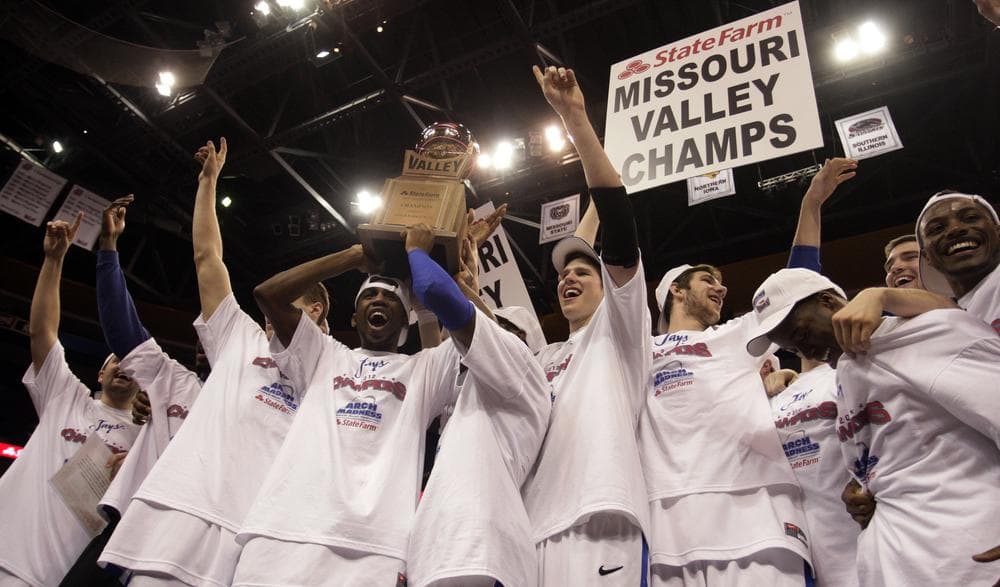Advertisement
High Financial Stakes For Mid-Major College Hoops
Resume
By Greg Echlin
At the men’s Final Four last year, Butler carved a path for mid-majors when the Bulldogs made it all the way to the championship game against Connecticut. Virginia Commonwealth University also made it to the Final Four after starting out in the First Four when the tournament field was expanded to 68. But despite all that success, mid-majors face more obstacles to capture an at-large bid than schools from the power conferences. When mid-majors are bypassed on at-large berths, the price is steep.
When I asked Wichita State coach Gregg Marshall last year about playing in a mid-major conference, it struck a nerve.
"Are we a mid-major?" he said.
I answered that the Missouri Valley Conference is regarded as a mid-major conference.
"Is it?" he said. "Well, check my bank account. Check my W-2. Check our budget. Check the way we travel. Check the crowd tomorrow. Check my talent in my program and tell me it’s a mid-major."
Check my bank account. Check my W-2. Check our budget. Check the way we travel. Check the crowd tomorrow. Check my talent in my program and tell me it’s a mid-major.
Gregg Marshall
Marshall prefers the term "non-BCS" over "mid-major." Keep in mind that he was miffed last year at the Shockers' exclusion from the NCAA tournament.
"The fallacy that you have to be in a BCS league and they deserve 11 bids and all this stuff is ridiculous," he said. "It’s ridiculous."
The Shockers won the National Invitation Tournament last year. With the regular season’s best conference record of 16-2 tucked away this year, they're certain to make the NCAA tournament. Wichita State is 27-5 overall and ranked 16th in this week’s AP poll.
The Valley’s automatic bid went to the conference tournament winner, Creighton, so the league will likely have two teams in the NCAA tournament for the first time since 2007. Under coach Greg McDermott, Creighton took the necessary path for mid-majors to make an impression — winning away from its home court.
"We’ve had a target on our backs since our win at San Diego State when we first entered the rankings," McDermott said. "There aren’t many schools like ours in a mid-major conference that are essentially ranked the entire season."
That was in late November when the Blue Jays won at San Diego State. Now Creighton, ranked 19th in the AP poll with a 28-5 record, is one spot behind the 18th-ranked Aztecs. 14 of Creighton’s wins were away from the CenturyLink Center in downtown Omaha. Adding a large number road games isn’t something mid-majors like to do, but it’s the only way to build schedule strength for the NCAA selection committee to consider. So fewer teams from BCS conferences travel to the home arenas of mid-majors. In December, when Missouri State played host to Oklahoma State, it was the first time in 10 years a Big 12 team played in Springfield, Missouri
"Scheduling is difficult to begin with," said Allen Ward, the athletics director at 11th-ranked Murray State in Kentucky. He knows the price a mid-major has to pay for 25 straight winning seasons.
Ward is very aware of the balance needed to please both the Tournament selection committee and the team's fans.
"You try to have some home games so you can build your season ticket package ... it’s difficult to have the ones that you’d want, regional, those that are attractive to your fan base come to Murray," he said. "So we fight that each and every year."
That fight has become part of the routine for mid-majors, according to Luke Winn, a college basketball writer for Sports Illustrated.
"Scheduling in college basketball is not fair right now for mid-majors," Winn said. "But the smarter teams are understanding what they need to do. They need to take some kind of risks in the early season and they can pay off later on."
[sidebar title="Murray State" width="250" align="right"] For more coverage on Murray State, check out Greg Echlin's story on the Racers from early February. [/sidebar]
The payoff is getting into the 68-team field in order to obtain a slice of the tournament’s television revenue. This is the second year of the NCAA’s 14-year, $10.8 billion contract with CBS and Turner Broadcasting. It’s the job of Missouri Valley Conference commissioner Doug Elgin to know how that money is distributed.
"For every game your conference plays in the 2012 NCAA tournament, it’s going to be about $1.5 million. Win or lose. But if you win you obviously get another opportunity, so if you go to the second round it’s about $3 million. If you get into the Sweet 16 and you lose in that round it’s about $4.5 million. It’s paid out over the next six years in increasing installments."
When a team that believes has the credentials is snubbed, it’s necessary for the coach to console his players and answer to his athletics director. Six years ago, Missouri State ranked 21st in Ratings Percentage Index, or RPI, a factor the committee uses to measure the strength of schedule. The Bears had won 20 out of its 28 games, but with television cameras present, blank faces filled the room as the team saw the bracket filled without Missouri State. Retired athletics director Bill Rowe was there.
"It cuts your heart out," Rowe said. "You ache for the team, the coaches and yet right at that particular moment it’s heartbreaking. There’s no other way to say it. That’s what it’s like."
Teams will find out if they're in or out this weekend on Selection Sunday.
This segment aired on March 10, 2012.